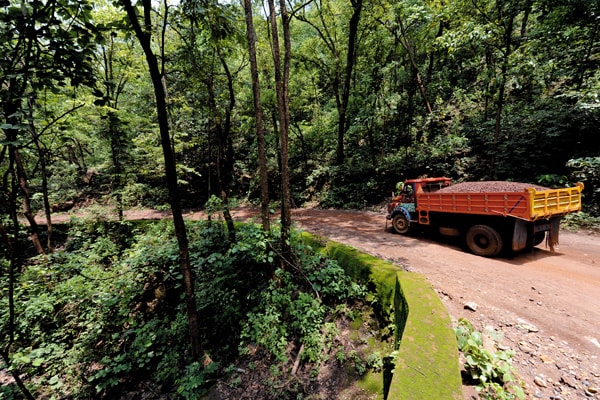Alienation: Business In the Red Corridor
A Jharkhand village lies trapped between the state and the Maoists
The motorcyclists honk incessantly on the empty path. Following a slippery, rain-soaked mountain trail, winding through a dense Sal forest, we are heading into the ‘liberated zone’ — a part of the Maoist fiefdom in the Saranda jungles of Jharkhand’s restive West Singhbhum district.
The region is impregnable to outsiders. The motorcyclists, who ferry the Forbes India reporter and photographer, are trusted intermediaries who had sought prior permission for entry from the local rebel commander. They know the rules all too well: If you are driving into Maoist country, you honk or play music loudly to tacitly announce your arrival to the rebels, who are mistrustful of outsiders. Or you risk being mistaken for a foe and toasted by one of their remote-controlled landmines littered across the rugged terrain.
After a long bone-crunching ride, we arrive in Baliba, a hardscrabble village seemingly in the heart of the rebel movement. In a post-midnight anti-guerilla operation led by paramilitary forces and the local police in late June, a local man — Mangal Honhaga, a 35-year-old farmer — was gunned down. About half a dozen others, suspected of being Maoists, were arrested. A rebel training camp near the village, which the authorities say was run by Samarji, the notorious zonal area commander of the banned CPI (Maoist), was busted. A cache of weapons and bagfuls of Naxalite literature were seized in the raid.
In the pouring rain, shoals of local villagers gather under a large, shaded tree to meet us. It is impossible to distinguish a rebel from a villager in the swelling crowd. No one is armed — at least not openly. A baby-faced man sidles up to us, claiming to be a representative of CPI(M). He closely examines our press IDs and then shows us around the village.
Baliba, cut off from the outside world, seems lodged in a time warp. The village has no electricity and no health centre. There is a school but no teacher. Everywhere there are malnourished children with distended bellies. We go around the village houses damaged in the raid, which involved hundreds of policemen who went from house to house in search of weapons.
Many villagers say they were hauled up by policemen for interrogation. The questions followed a familiar pattern: Are you a Maoist? Have you seen a Maoist? Have you been to their camp for armed training? Some were picked up and taken away in a helicopter. No one knows where.
The residents of Baliba deny being Maoist sympathisers, but concede that guerrillas often swoop in from the nearby jungles for nightly rests and meals. They offer them food because they don’t have a choice. Would you oppose militants wielding guns if they entered your house, they ask us.
The majority feels trapped between the state and the Maoists. However, they are more suspicious of the state than the Maoists. Such raids, many believe, are meant to vacate and usurp their lands for large mining corporations lusting after the region’s rich iron-ore deposits. Naxalites are like ants
attempting to drive away elephants.
Manjiri Honhaga, Mangal’s widow, stands quietly among the crowd, swaddled in a shawl. She clutches her three-month-old baby, sick and emaciated, with a dim chance of survival. Her brother-in-law, Dosara Honhaga, is angry. Authorities say Mangal was killed in a cross fire with the rebels. Dosara and other villagers claim he was murdered. “Now you know why people are becoming Naxalites,” he says.
An invisible conflict, raging across vast swathes of the countryside, is eating away at the innards of modern India. The country’s future rests on its outcome.
Naxalites have foothold in 23 of India’s 28 states. They are most active in a loosely contiguous mineral-rich territory known as the ‘red corridor’ that spans across Chhattisgarh, Jharkhand, Orissa, and Bihar. In China today, Mao Zedong is a relic of a bygone era. But in this remote jungle terrain, Mao is the guiding light for armed rebels.

Image: Dinesh Krishnan
Smooth Ride Many mining companies strike a deal with the Maoists to run their business
Prime Minister Manmohan Singh has repeatedly warned that India’s economy risks losing out on sustained growth unless the red corridor is freed from the grips of Maoism.
At stake are investments worth $80 billion, which can be secured with access to the region’s rich deposits of iron ore, coal, bauxite and manganese, says the London-based investment banking group Execution Noble. The Federation of Indian Chambers of Commerce and Industry says the conflict threatens to “stall industrial-investment plans just when India needs to ramp up its industrial machine”.
The home ministry estimates that between January 2007 and June this year, Naxalites attacked 1,241 “economic targets” — damaging power plants, roads, mines, railway property, telephone towers, and electricity transmission lines across nine states. Jharkhand is endowed with India’s richest mineral wealth. Naxalites have a presence in 18 of its 24 districts, mostly in regions with the highest concentration of mineral wealth.
Doing business in a conflict zone is, of course, risky. But the risks can be mitigated by winning over local support. Or so claims Essar Power, which last year began constructing its ambitious TORI power project — a 2,000 MW power plant at Chandwa in Latehar district. Besides CPI(M), about half a dozen other armed gangs operate in this region.
But Rajneesh Bhardwaj, a senior manager, says winning over local populations is the only way to survive in such an environment. For that, he says, the company has developed an empathetic approach to local socio-economic issues; it has refrained from involuntary acquisition of land; and in many instances has offered more compensation than required by the state.
The power plant’s first two units of 1,200 MW capacity will come up on 1,000 acres of land for an investment of Rs. 5,000 crore. Around 550 acres have so far been purchased from four villages at Rs. 5 lakh per acre, more than the government-stipulated compensation of around Rs. 2 lakh per acre. The plant will create employment for around 5,000 locals. It has set up a local dispensary in a region that never had a hospital, a school, and a concrete house even for those families who earlier lived in thatched huts.
“We want to send out a message that industry is not the enemy; ignorance is,” says another company employee. “We’ve started winning local confidence. Now we often get tip-offs from local villagers about the movement of armed groups when we venture out.”
But corporate social responsibility (CSR) efforts don’t always work. In many parts of Saranda, several mining companies reserve a shoe-string budget for CSR, and are reluctant to share profits with locals. Most iron-ore mines kick up clouds of red dust, which seeps into the soil and depletes its fertility. The disillusionment with companies, blindly pursuing profit, often transforms the region into a fertile Maoist recruitment ground.
For Essar Power, there are a number of other risks involved. About half a dozen employees of its rival Abhijeet Group (which is building a 1,740 MW power plant in its vicinity) have been killed in the past few years.
In June, an employee and a CRPF jawaan were killed when they went looking on a nearby hillock for two co-workers kidnapped in March. A ransom of Rs. 50 lakh was demanded for the kidnapped employees — they, too, were shot dead.
In 2009, four security guards working for the company were gunned down by suspected members of the Tritiya Prastuti Committee (TPC), a splinter group of the CPI(M).
In April, Manoj Ojha, the general manager of Reliance Power, was shot dead in the nearby Chatra district, while the company’s vice president, H. Bhuj, was grievously injured. The incident, the first involving top employees, sent shockwaves through the business world. Acquiring and retaining talent to work in such an environment is a challenge, Essar officials say. Frequent and prolonged bandh calls by Maoists also take a heavy toll on business.
A 100-strong battalion of the Special Auxillary Police (SAP), comprising ex-army men, guards the plant site. The state government is also preparing a special battalion of the State Industrial Security Force (SISF) that will receive training from the Central Industrial Security Force (CISF).
But SAP or SISF cannot provide the psychological security that money can buy. Companies that do business here admit that ‘protection money’ is paid to the rebels every month to not cause harm to its investment. According to the home ministry, Jharkhand contributes the highest share to the Maoist exchequer — around Rs. 1,000 crore annually.

Image: Dinesh Krishnan
Bleak Future The half-constructed structure of the primary school in Baliba; classes are held in people’s homes, whenever the teacher comes
In a 2007 ministry report, leaked last year by the Hindi weekly Chauthi Duniya, the ministry listed more than 550 money sources across 15 districts of Jharkhand. They included coal miners, iron-ore miners, wood smugglers, and most shockingly — government officials responsible for implementing social schemes such as the National Rural Employment Guarantee Scheme.
Businesses and rebel groups are nurturing each other by forging a symbiotic relationship, says Xavier Dias, a leading political activist in Jharkhand. “A classic way to check which mining company has had a deal with Maoists is to check out whose trucks are on the roads during a Maoist bandh,” he says. The wealth is enabling the rebels to get increasingly militarised.
Once known for their rudimentary weapons, they are increasingly using rocket launchers, sniper rifles, and mortar launchers in combat. In recent raids on Maoist camps in Saranda, paramilitary forces also discovered large number of explosives and detonators used by stone crushing units and mining companies in the region. It is anybody’s guess how these explosives are falling into the hands of Naxalites.
In Baliba, residents point out that the government arrests villagers forced to offer food to Naxalities. Why are businesses empowering Naxalites let off the hook? It’s easy to see why the government is considered the epitome of cruelty and brutality. Naxalites effortlessly fill the power vacuum.
Before we leave, the baby-faced man who chaperones us around the village pulls out his mobile phone and rings Samarji. Jharkhand’s most wanted man is somewhere deep inside the jungles of Saranda. An interview cannot happen.
But baby-face won’t send us away without a quote. He delivers a long and rambling sermon on the Maoist philosophy: Something about greed, poverty. In the crowd, Manjiri Honghana listens to him with a vacant look. Her three-month-old peers out listlessly from her shawl. The rain continues to pour.
(This story appears in the 26 August, 2011 issue of Forbes India. To visit our Archives, click here.)
















